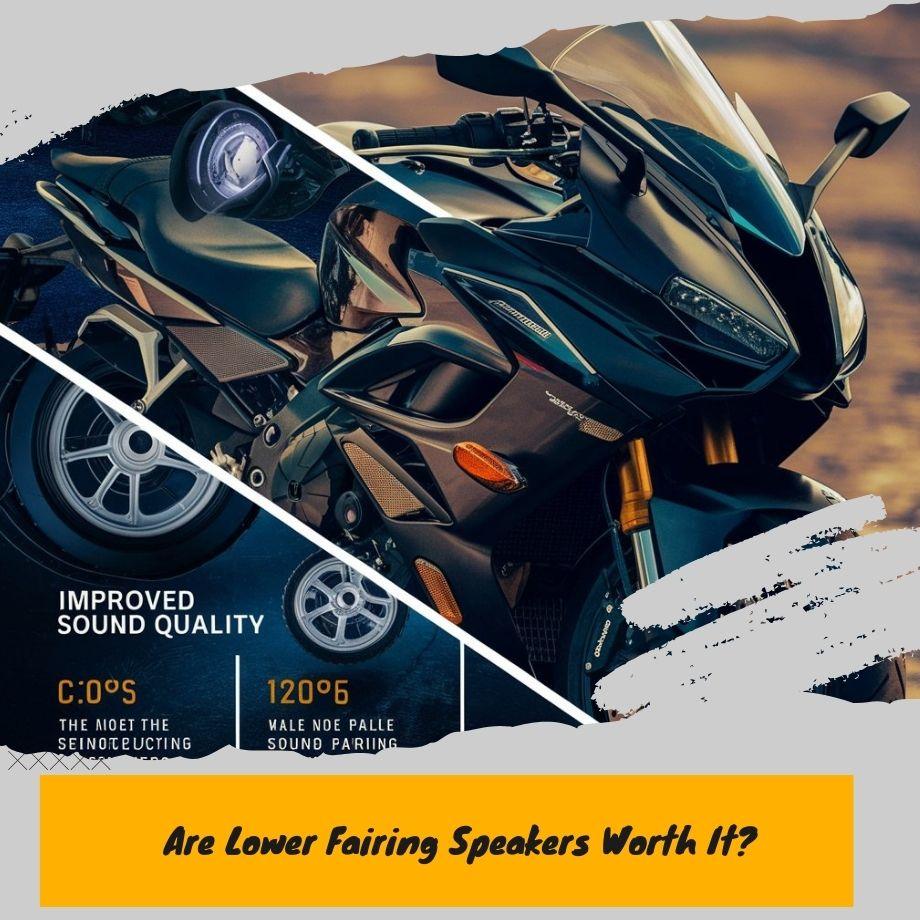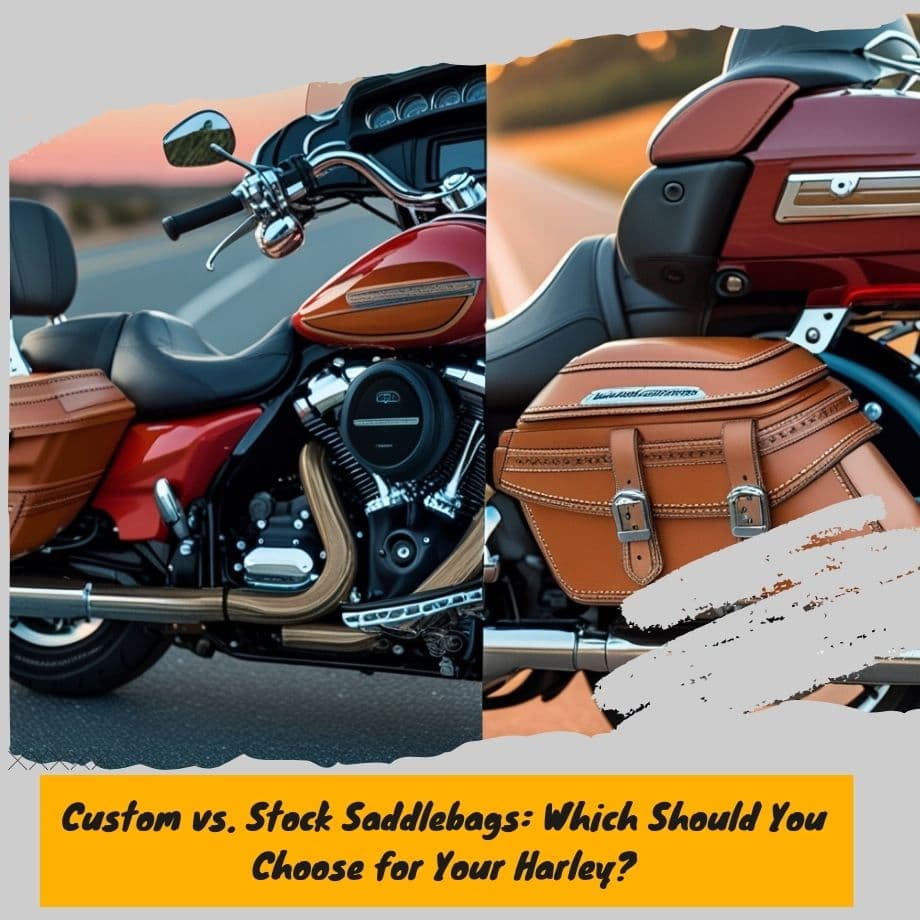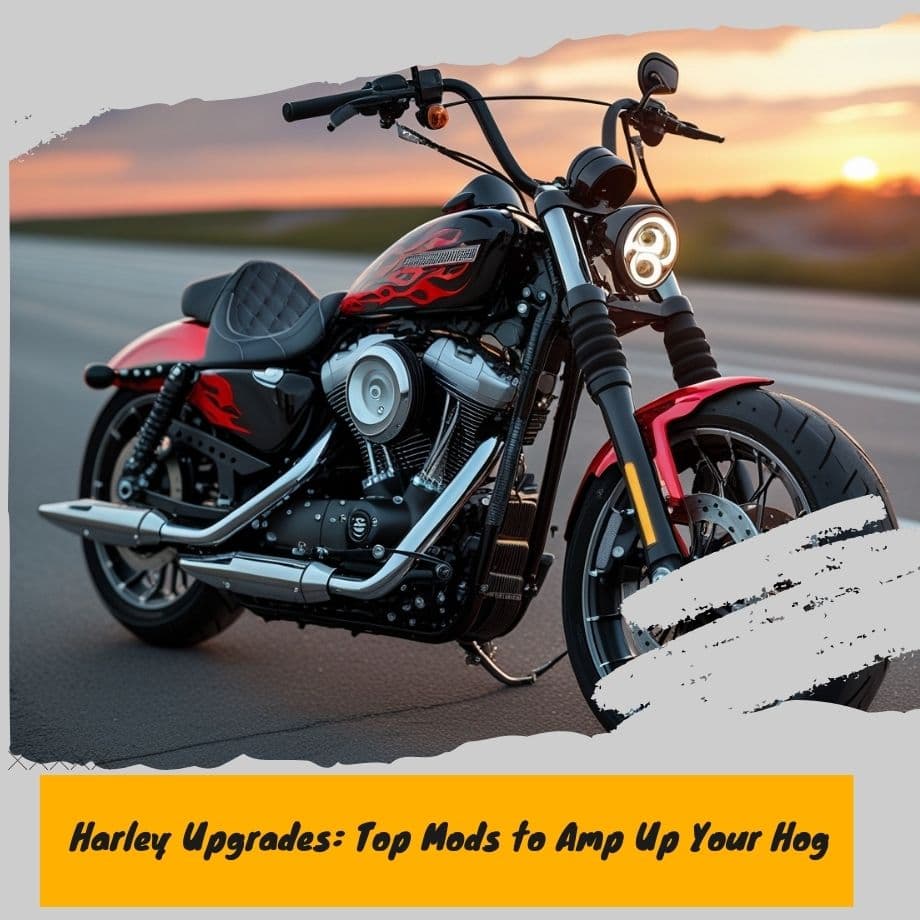The Lower Fairing Speaker Debate: Insights from Seasoned Riders

Motorcycle fairing speakers are audio speakers that are mounted inside the lower fairings on motorcycles.
Unlike stock speakers which are usually small and basic, lower fairing speakers are larger, higher-powered speakers designed to deliver louder, clearer sound compared to standard motorcycle audio systems.
The lower fairings on most motorcycles have enough space to install aftermarket speakers, providing the ideal location for directing sound towards the rider.
Lower fairing speaker kits include the required brackets, wiring harnesses and hardware for straightforward installation.
The main purpose of lower fairing speakers is to improve the overall audio experience during rides. They allow riders to listen to music, GPS directions, phone calls and more with enhanced volume, range and clarity, even at high speeds or in noisy environments.
While not essential, many riders add lower fairing speakers to amplify and upgrade their bike's sound system for more enjoyable rides.
Benefits of harley lower fairing speakers
Lower fairing speakers can significantly enhance the audio experience while riding a motorcycle. Here are some of the key benefits they provide:
Improved Sound Quality and Volume
Lower fairing speakers are larger and more powerful than stock speakers, allowing for louder volume and clearer sound.
You May Also Like to know about: Types of Lowers on Harleys
The speakers are positioned closer to the rider's ears and are angled to project sound directly at the rider. This avoids the issues with wind noise interference that can diminish sound from handlebar or helmet speakers.
Better Audio Experience While Riding
With higher-quality components and strategic placement, lower fairing speakers create immersive, high-fidelity sound even at highway speeds.
You can enjoy music, podcasts, or audiobooks without distortion or fading. This allows for a more enjoyable and entertaining ride.
Customizable and Upgradeable
Lower fairing speaker kits are available in different wattages and configurations. You can customize the setup based on the size of the fairing and desired volume levels.
Many kits include amplifiers and sound processing units for further audio tuning. Replacement components are readily available for upgrading the system over time.
8 inch lower fairing speaker pods
8-inch lower fairing speaker pods are a popular choice for riders who want a significant improvement in sound quality from their motorcycle's audio system.
These larger speakers can produce more bass and overall volume than the stock speakers, resulting in a more immersive listening experience.
However, it's important to note that installing 8-inch lower fairing speaker pods may require modifications to the fairing to accommodate their larger size.
In some cases, this may involve purchasing aftermarket fairings that are specifically designed for larger speakers.
Potential Drawbacks
Lower fairing speakers come with some downsides to consider before installation.
The most obvious is the added cost, both for the speakers themselves and professional installation if you don't do it yourself. Lower fairing speaker kits can range from $100 to over $500 depending on the brand and motorcycle model.
You'll also need to factor in labor costs if not installing them yourself, which can add $100 or more to the total price. This investment may not make sense if you only occasionally listen to music while riding.
For some motorcycles, especially smaller and mid-sized bikes, lower fairing speakers provide a minimal improvement over stock speakers. The smaller fairing area on naked bikes and sport bikes won't give the speakers enough air space to optimize the sound.
Riders of these bike types may be better served with a helmet headset or Bluetooth communicator with high quality speakers. That brings the sound closer to your ears without major modifications.
One potential drawback is that lower fairing speakers can drain the motorcycle's battery faster, since they require more wattage than factory speakers.
This depends on the amps of the speakers and overall electrical system, but is something to be aware of.
Also consider that lower fairing speakers are fixed in place, so you lose the ability to easily bring music with you off the bike.
For maximum flexibility, portable Bluetooth speakers may better suit riders who frequently listen to music both on and off their motorcycle.
Installation Process and Complexity
Installing lower fairing speakers on a motorcycle can range from straightforward to quite complex depending on the bike model and your technical skills. There are two main options - DIY installation or hiring a professional auto shop or dealer to handle it.
For DIY, you'll need basic mechanical skills and wiring knowledge. Most lower fairing speaker kits come with instructions, but you'll be removing bodywork panels, running new speaker wires, and mounting the speakers securely.
This involves drilling holes for speaker mounts, splicing into existing wiring, connecting terminals, and testing for full functionality.
Plan on dedicating a full afternoon or weekend for the project if new to motorcycle upgrades.
Professional installation through a shop or dealer is less hands-on but adds to the total cost. The benefit is having an expert handle the wiring, mounting, and integration with the bike's electrical system.
They'll ensure proper speaker polarity, gain staging, and operation. Shop rates vary, but expect 1-3 hours of labor for installation.
Key steps for either DIY or professional install include:
- Removing necessary bodywork like the fairings to access the area
- Measuring and cutting speaker mounting holes if not pre-existing
- Running new speaker wires from the battery/fuse to speaker location
- Securely mounting speakers and enclosures to prevent vibration issues
- Connecting wiring harnesses and terminals properly
- Re-assembling body panels and testing speaker operation
- Adjusting any settings on amplifiers or audio units
Proper planning, bike disassembly skills, and attention to detail in wiring and mounting will ensure the speakers function as expected. Seek help online or consult bike-specific forums for tips on more complex installs.
Cost Considerations
Lower fairing speakers can range in price from $100 to $500 or more for a high-end set.
The specific cost depends on factors like speaker size, power handling, sound quality, and brand reputation. In general, 6.5-inch speakers tend to cost $150 to $300, while 4-inch speakers are $100 to $200.
You'll also need to account for labor costs if you don't install the speakers yourself.
Most shops charge $50 to $100 per hour for motorcycle audio work. Basic speaker swaps may take 1-2 hours, while a full rewiring with amps could take 4+ hours.
The cost of Street Glide lower fairing speakers can vary depending on the brand, size, and power output. It's important to weigh your budget against the desired audio quality and features.
Over the long run, lower fairing speakers can provide great value if you ride frequently and want an immersive audio experience.
Upgrading from low-quality stock speakers makes a significant difference in sound clarity and volume. The improved experience and riding enjoyment is worth the investment for many riders.
Properly installed lower fairing speakers should last for years of riding if protected from the elements.
Replacing worn out stock speakers with higher-end components that match your bike can make the costs worthwhile in the long run. Just be sure to balance your audio needs and budget to avoid overspending.
best motorcycle fairing speakers
When shopping for lower fairing speakers, it's important to choose a reputable brand known for motorcycle audio quality and reliability. Here are some best lower fairing speakers to consider:
J&M Audio
J&M Audio is one of the leading brands for motorcycle speakers and audio accessories. Their lower fairing speaker kits come highly rated for clear, balanced sound with good volume levels. Popular models include:
- J&M AS-8R: 8-inch coaxial speakers with durable poly cones and butyl rubber surrounds. Rated for 50 watts RMS power handling.
- J&M TS-A400: High-fidelity 4-inch speakers with titanium dome tweeters. Deliver crisp highs without distortion.
- J&M AS-5X: Reasonably priced 5.25-inch speakers with polypropylene cones. Provide full-range audio in a compact size.
Kicker
Known for their car audio systems, Kicker also makes motorcycle-specific speakers built to withstand vibration, moisture, and road debris. Quality picks include:
- Kicker 47KMA8304: 8-inch speakers with polypropylene woofers and titanium tweeters. 80 watts RMS power handling.
- Kicker 47KFM6934T: 6x9-inch speakers with poly injection cones and 360-degree mounting. Deliver loud, clear sound.
- Kicker 47KFC6931T: High-output 6.5-inch speakers with extended voice coils. Rugged and water resistant.
Boss Audio Systems
For budget-friendly lower fairing speakers, Boss Audio delivers decent sound quality at lower prices. Look at models like:
- Boss Audio MC470B: Affordable 6x9-inch speakers with poly cones and butyl rubber surrounds.
- Boss Audio MC680B: 6.5-inch speakers with Mylar tweeters and adjustable angle mounts.
- Boss Audio MC300B: Compact 4-inch speakers well-suited for tight fairing spaces.
Reviews indicate Boss Audio speakers provide good bang for your buck, though may lack the audio fidelity of premium brands.
Compatibility Factors
Lower fairing speakers are designed to be compatible with most motorcycles that have fairings, but they work best with certain bike styles and may require additional upgrades on some models.
Cruisers and touring motorcycles tend to be the most compatible out of the box since they have large fairings with sufficient space to install speakers.
Harley-Davidsons, Honda Goldwings, BMW touring bikes, and other long-distance cruisers can usually accommodate lower fairing speakers without issue.
Sport bikes and naked bikes have more limited fairing space, so lower fairing speakers may need to be compact or custom mounted. Slimmer speaker modules are available, but the sound quality may suffer on more powerful superbikes.
On dual-sport, adventure, and off-road bikes, the irregular fairing shapes can make speaker mounting a challenge. Custom brackets or fairing modifications may be required to properly install lower fairing speakers on these motorcycle types.
Upgrading the head unit or amplifier is often necessary to get the most out of new lower fairing speakers.
The existing system may not provide enough power to drive speakers that are larger or more efficient than stock. Amplifier upgrades ensure the speakers can reach full volume and sound quality potential.
For older or basic motorcycle models without sophisticated audio systems, additional wiring work and mounting hardware may be required.
While any bike can be retrofitted with lower fairing speakers, the installation process is much simpler on newer bikes with robust electrical systems and sufficient fairing space.
Alternatives for Audio Upgrades
Riders looking to upgrade their motorcycle's sound system have several options beyond installing lower fairing speakers. Here are some popular alternatives:
Helmet Speakers and Headsets
One of the simplest audio upgrades is adding high-quality speakers or a Bluetooth headset inside your helmet. Helmet speakers allow you to listen to music and take calls privately without blasting sound externally. Top helmet speaker brands include Sena, Cardo, Uclear, and JBL.
Key benefits of helmet speakers:
- Improved sound quality directly in your ears
- No installation required
- Portable between different helmets
- Allow safe use of phone and GPS navigation
- Won't drain your motorcycle's battery
Potential downsides include less volume than external speakers and wind noise interference at high speeds.
Handlebar or Saddlebag Speakers
Mounting compact speakers onto the handlebars or saddlebags is another easy audio upgrade. Brands like Kuryakyn sell handlebar speaker pods that quickly clamp into place.
Benefits of handlebar speakers:
- Convenient mounting without major installation
- Can position speakers closer to your ears
- Adjustable positioning and removable
Drawbacks can include more wind noise, less stereo separation, and exposed speakers prone to weather or damage.
While installing speakers on your Sportster is a popular option, other alternatives include adding a helmet headset or handlebar-mounted speakers for a more discreet audio solution.
Amplifiers and Processors
Adding an external amp and audio processor can significantly boost the volume and sound quality from your motorcycle's stock speaker system. This option requires professional installation but avoids replacing the speakers themselves.
Key benefits include louder, high-fidelity sound and the ability to tune the equalizer. Downsides are the installation cost and drain on your battery.
Impact on Battery
Lower fairing speakers can potentially drain a motorcycle's battery faster compared to the stock audio system, especially when played at louder volumes.
This is because aftermarket speakers draw more current from the electrical system.
The additional current draw depends on the power handling of the new speakers. More powerful speakers will require more wattage, putting greater strain on the charging system. Running lower fairing speakers at full blast for extended periods might prematurely drain the battery.
Riders who install lower powered speakers likely won't notice significant battery drain. But those opting for high wattage systems could experience issues, particularly on older bikes.
Preventive measures include upgrading to a higher output charging system, or installing a capacitor to supplement the bike's electrical system.
It's a good idea to check the condition of the battery and alternator before installing lower fairing speakers.
Replacing worn parts ahead of time ensures the electrics can handle the extra current draw. With the right supporting mods, lower fairing speakers can be added without compromising the battery or charging system.
Maintenance and Durability
Lower fairing speakers are built to withstand the elements and rigors of motorcycle riding. However, their lifespan and durability depends on several key factors:
Weather and Water Resistance
Most quality lower fairing speakers come with marine-grade construction and waterproofing. This enables them to handle rain showers and the occasional splash without damage.
Completely submerging them underwater is not recommended though. Make sure any exposed wiring or connections have protective covers as well.
Vibration Protection
The constant vibrations from riding can take a toll on speakers over time. Using speakers with rubberized or suspended mounting systems helps dampen vibration.
Avoid rigidly mounted speakers that transfer more vibration through the housing. Some damping material inside the speaker enclosure also helps prolong speaker life.
Lifespan and Longevity
With proper installation and occasional maintenance, a set of lower fairing speakers can realistically last 3-5 years or longer. Heat, UV exposure, and very loud volume levels can accelerate deterioration of the speaker components.
Periodically checking the speaker cones and surrounds for cracking or fatigue can identify issues early. Replacing worn speakers before failure preserves your system's sound.







Leave a comment